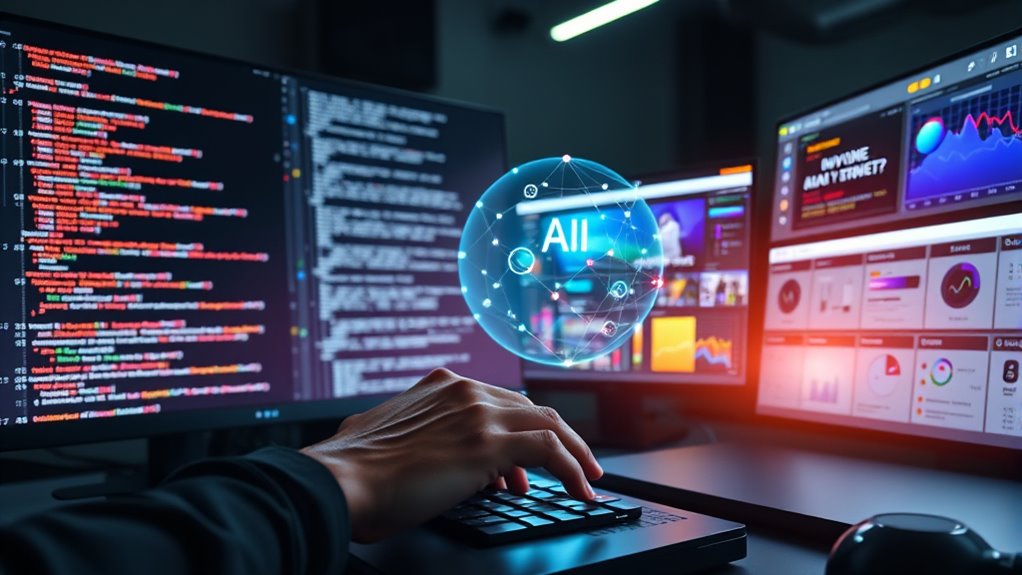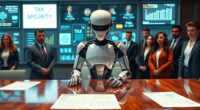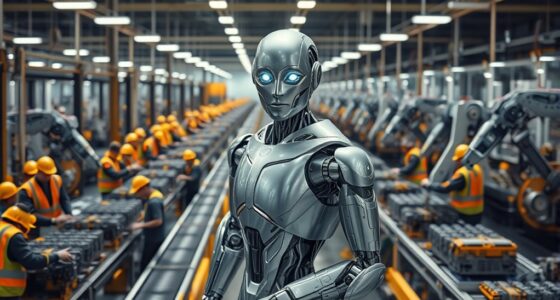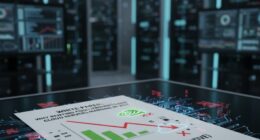Coding will definitely continue to be essential alongside no-code AI tools. While no-code platforms make AI more accessible for quick projects and non-technical users, they don’t offer the deep customization, scalability, and complex workflow management that coding provides. As AI applications grow more advanced, skilled developers will remain crucial for fine-tuning models and building enterprise solutions. If you want to explore how these tools complement each other, keep exploring further.
Key Takeaways
- Coding remains essential for complex AI workflows, enterprise solutions, and advanced model customization.
- No‑code tools excel in rapid prototyping but lack scalability for large-scale, production-level projects.
- Skilled developers will continue to be in demand for troubleshooting, optimization, and building sophisticated AI systems.
- Hybrid approaches combining no‑code and coding will dominate future AI development environments.
- Coding’s flexibility and control ensure its longevity alongside evolving no‑code AI platforms.

In today’s AI landscape, both coding and no‑code tools play essential roles in developing intelligent applications. Coding remains the preferred choice for technical users—developers who demand full control over machine learning (ML) pipelines, data preprocessing, and model tuning. It provides the flexibility to customize hyperparameters, optimize algorithms, and scale solutions for enterprise-grade systems. The output from coding is portable, editable source code, giving you the ability to adapt and evolve your applications over time. This level of control becomes critical when managing complex workflows, ensuring performance, and maintaining security standards. Recognizing the significance of angel numbers in understanding deeper connections can also inspire developers to explore intuitive and symbolic aspects of their work.
Coding provides essential control, customization, and scalability for advanced AI workflows and enterprise solutions.
On the other hand, no‑code AI platforms target non-technical users like marketers and analysts who need rapid deployment without deep technical expertise. These platforms simplify AI integration through visual interfaces, drag-and-drop workflows, and automated processes. They excel at tasks like smart data processing—cleaning data, recognizing patterns, and offering real-time insights—without requiring you to write a line of code. No‑code tools also support intelligent automation, optimizing workflows and resource allocation, and enhance user experience through NLP features such as chatbots, voice processing, and personalized interfaces. Automated testing and data management features further empower non-technical teams to develop, test, and deploy AI solutions swiftly.
The evolution of development tools reflects these differences. No‑code replaces traditional coding with visual logic, making AI accessible to a broader audience. AI agents augment developers by generating code, speeding up tasks like debugging and code generation, and enabling full code-level customization when needed. Interfaces vary from drag-and-drop GUIs for no‑code platforms to prompt-based or IDE environments for AI coding tools. This diversity supports different user bases—non-technical staff versus professional developers—and allows for flexible adaptation to project requirements.
Looking ahead, no‑code platforms are particularly strong for prototyping and creating minimum viable products quickly. However, they face limitations in scalability and deep customization, which are areas where coding still dominates. Complex enterprise workflows, advanced model tuning, and troubleshooting require the precision and flexibility that only coding provides. As AI tools evolve, many teams will continue to combine both approaches—using no‑code for rapid development and prototyping, while relying on coding for production-level, scalable solutions.
Despite the rise of no‑code AI, coding isn’t likely to disappear. Instead, it will coexist, serving different needs. No‑code democratizes AI development, but the depth, control, and scalability of coding remain indispensable for advanced, large-scale projects. The demand for skilled developers continues to grow as AI applications become more complex and integrated into enterprise systems. As AI tools advance, they will complement rather than replace coding, enabling developers to focus on innovation while non-technical users handle simpler tasks. The future of AI development will be a hybrid landscape, where both coding and no‑code tools thrive side by side.
Frequently Asked Questions
Will Coding Skills Become Obsolete in the Next Decade?
You might wonder if coding skills will become obsolete soon. The truth is, while AI tools and no-code platforms streamline many tasks, your coding abilities remain crucial for complex, customized projects, debugging, and system integration. As technology evolves, you’ll need to adapt and upskill, blending traditional coding with AI literacy. Your foundational skills will continue to be essential, especially for niche applications and ensuring technology aligns with ethical and security standards.
How Will No-Code AI Tools Impact Software Development Employment?
You might worry about job security as no-code AI tools grow. They automate routine tasks, reduce team sizes, and shift budgets from hiring to AI investments. Junior roles face higher automation, and the IT unemployment rate has risen to 5.7%. While some jobs may decline, new roles in AI management and hybrid development will emerge, transforming the industry rather than eliminating coding entirely.
Can No-Code Tools Handle Highly Complex or Specialized Projects?
You might wonder if no-code tools can manage highly complex or specialized projects. They excel at automating routine, multi-step workflows, integrating external APIs, and scaling for enterprise needs. While they handle many tasks efficiently, there are limits in customization and fine-grained control. For niche or highly technical projects, traditional coding often remains essential, but no-code tools continue to evolve, expanding their capabilities for more specialized applications.
What Ethical Issues Arise From Automated Coding and Ai-Generated Software?
When you use AI-generated software, ethical issues surface around transparency, ownership, and accountability. You might struggle to disclose AI’s role, risking misrepresentation or intellectual property disputes. Security and quality concerns also arise if you don’t thoroughly review AI-produced code, which could lead to vulnerabilities or biased outputs. It’s essential that you consider these ethical challenges to guarantee responsible use and maintain trust in your development process.
Will Coding Remain Essential for AI Tool Development and Customization?
Imagine you’re building an AI-powered app. Even as no-code tools grow, your coding skills remain essential for customizing features and fixing issues no AI can handle. You’ll need to understand languages like Rust or Dafny for safety and verification. Coding helps you oversee AI-generated code, troubleshoot bugs, and develop new AI languages. So, while tools evolve, your foundational coding skills stay critical for innovation and reliable AI development.
Conclusion
As you watch the rise of no-code AI tools, remember that coding is like a skilled craftsman’s chisel—adapting and shaping new tools to create masterpieces. When I started exploring these platforms, I saw how they democratize innovation, much like how the printing press expanded knowledge. Coding isn’t disappearing; it’s evolving. Embrace these tools as your new toolkit, knowing that, just like a craftsman, your mastery will turn simple blocks into extraordinary creations.









